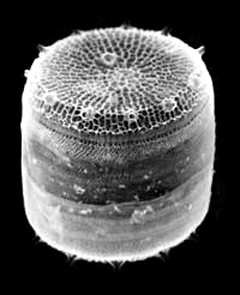Emerging Science Note/Diatoms
Air Date: Week of February 29, 2008

Diatoms are unicellular algae. This Thalassiosira pseudonana has a hard outer shell of silica. (Courtesy of U.S. Department of Energy)
Sea algae may be the key to faster computer chips. Living on Earth’s Margaret Rossano reports.
Transcript
CURWOOD: Just ahead, why frogs have nothing to celebrate this Leap Year. But first this note on emerging science from Margaret Rossano.
ROSSANO: The pioneers of Silicon Valley probably never imagined that the key to faster computers might lie in algae – the simple, plant-like organisms that create red tides and make your fish tank murky.
But some scientists now think that diatoms - a kind of algae that lives in the ocean - might help them build speedier computer chips.

Diatoms are unicellular algae. This Thalassiosira pseudonana has a hard outer shell of silica. (Courtesy of U.S. Department of Energy)
Genetic control of silica production could be a major breakthrough when it comes to manufacturing computer chips. Currently, the circuit patterns on chips are cut with beams of ultra violet light, but diatoms could produce much finer lines. More lines mean room for even more transistors—the millions of tiny electrical switches that are the building blocks of computer chips—and a faster chip overall.
The research team hopes they can control and guide the diatoms silica-making, so that someday these microscopic algae can help produce a faster computer for you.
And that’s this week’s note on emerging science. I’m Margaret Rossano.
CURWOOD: Coming up- emerging science of the brain and some unexpected perils of poverty. Keep listening to Living on Earth.
Living on Earth wants to hear from you!
Living on Earth
62 Calef Highway, Suite 212
Lee, NH 03861
Telephone: 617-287-4121
E-mail: comments@loe.org
Newsletter [Click here]
Donate to Living on Earth!
Living on Earth is an independent media program and relies entirely on contributions from listeners and institutions supporting public service. Please donate now to preserve an independent environmental voice.
NewsletterLiving on Earth offers a weekly delivery of the show's rundown to your mailbox. Sign up for our newsletter today!
 Sailors For The Sea: Be the change you want to sea.
Sailors For The Sea: Be the change you want to sea.
 The Grantham Foundation for the Protection of the Environment: Committed to protecting and improving the health of the global environment.
The Grantham Foundation for the Protection of the Environment: Committed to protecting and improving the health of the global environment.
 Contribute to Living on Earth and receive, as our gift to you, an archival print of one of Mark Seth Lender's extraordinary wildlife photographs. Follow the link to see Mark's current collection of photographs.
Contribute to Living on Earth and receive, as our gift to you, an archival print of one of Mark Seth Lender's extraordinary wildlife photographs. Follow the link to see Mark's current collection of photographs.
 Buy a signed copy of Mark Seth Lender's book Smeagull the Seagull & support Living on Earth
Buy a signed copy of Mark Seth Lender's book Smeagull the Seagull & support Living on Earth

